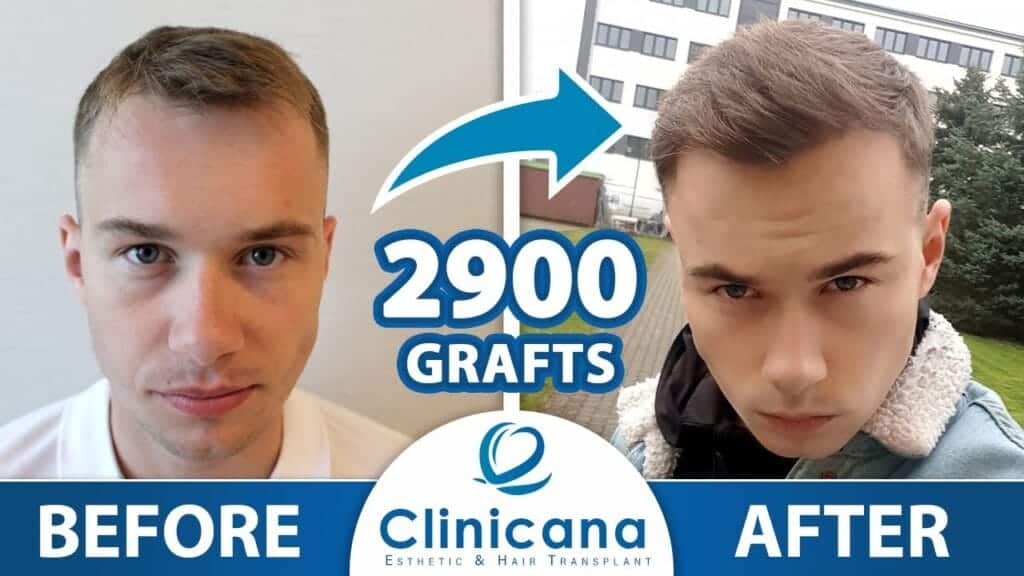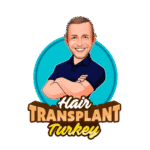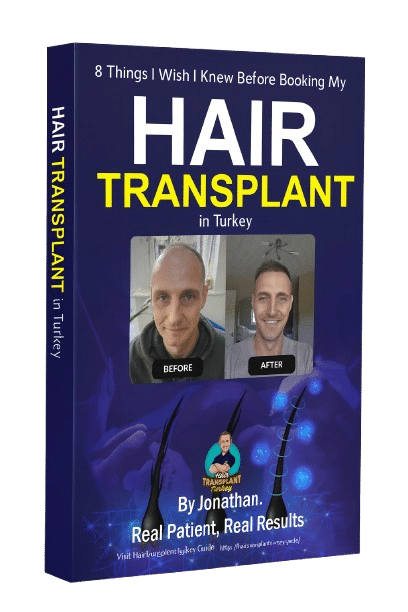If you’ve ever typed “Does a hair transplant hurt?” into Google, you’re definitely not alone. I did the same thing countless times before booking my own procedure in Istanbul. Some people online said it was painless, others made it sound unbearable — and I didn’t know who to believe.
In this post, I’ll share the honest truth about how much a hair transplant actually hurts, based on my real experience with Clinicana Hair Transplant & Esthetic Surgeries in Turkey, as well as insights from trusted medical sources like the Mayo Clinic and ISHRS.
By the end, you’ll understand exactly what to expect before, during, and after the procedure — and why the fear of pain is usually far worse than the reality.
Why “Does It Hurt?” Is the Most Common Hair Transplant Question
It’s completely natural to worry about pain. For most of us, it’s not just about the surgery itself — it’s the idea of someone working on our scalp for several hours. Before I went to Turkey, I delayed getting a transplant for years mainly because I didn’t have the knowledge or confidence to move forward.
The truth is, every patient’s pain threshold is different, but modern hair transplants — especially FUE (Follicular Unit Extraction) and DHI (Direct Hair Implantation) — are minimally invasive procedures. As the British Association of Dermatologists explains, local anaesthetic makes the process comfortable and manageable.
When I finally flew to Istanbul and checked into the Acıbadem Taksim Hospital, where Clinicana operates, I made it my mission to document exactly what it really feels like.
Before the Procedure – The Anaesthetic (The Only Real Discomfort)
The only time I’d describe as “painful” was right at the start, when the anaesthetic is injected into the scalp. Think of it like a series of small stings — sharp but brief.
At Clinicana, they used a very fine needle and chilled the area first to make it easier. The sensation lasted around 30 seconds. After that, I didn’t feel any pain at all. The team checked regularly if I was comfortable and added more anaesthetic whenever necessary.
Pain level during anaesthetic: 3/10 for less than a minute.
Once numb: 0/10 for the rest of the procedure.
The ISHRS confirms that local anaesthesia is the standard worldwide and that any pain is short-lived. Some clinics offer light sedation, but I didn’t need it — a calm, professional environment made a huge difference.
From there, things only got easier.
During the Procedure – What It Actually Feels Like
The surgery itself took about seven hours, split into two main phases: extraction and implantation.
FUE Extraction Phase
You lie face down while the donor hair (usually from the back of your head) is removed one follicle at a time using a tiny tool called a micro punch. Because the scalp is completely numb, there’s no pain — only the faint vibration and hum of the machine.
At Clinicana, I appreciated how attentive the team was. Every 30 minutes or so, someone checked if I was feeling anything and offered breaks for water or snacks.
Implantation Phase
After extraction, you’re repositioned, and the new grafts are carefully implanted into the recipient area. I could feel light pressure or tapping sensations, but never sharp pain. It’s more like someone gently pressing on your scalp.
I listened to music and even dozed off during parts of it. The clinic kept everything relaxed and unhurried, which helped a lot.
By the time it was over, I remember thinking: “That’s it? I was expecting so much worse.”
→ But the real test comes in the hours and days after the surgery.
After the Procedure – The First Few Days
When the anaesthetic wears off, you can feel a bit of tightness or tenderness, especially in the donor area. I was given antibiotics, anti-inflammatories, and mild painkillers, and honestly, they worked perfectly.
That evening, the sensation was more of a dull ache (2/10) rather than pain. I slept slightly upright for the first two nights to prevent swelling.
Day 1–3
Some swelling around the forehead is normal — it looks worse than it feels and disappears within a few days. I returned to the clinic for a free scalp wash and aftercare tutorial, which was reassuring. The back of my head was a little sore at night so I took paracetamol and slept slightly upright.
Day 4–10
Scabs start to form and then fall off naturally. There’s often some itchiness, but no pain at all by this point. Clinicana’s aftercare shampoo and saline spray helped keep everything comfortable.
According to a PubMed study on FUE recovery, most patients rate pain under 3/10 in the first 48 hours — completely consistent with my experience.

Here’s how I’d personally rate each stage:
| Stage | What I Felt | Pain Level (1–10) | Duration |
|---|---|---|---|
| Anaesthetic Injections | Sharp stings | 3/10 | 30 seconds |
| Extraction Phase | None | 0/10 | 3 hours |
| Implantation Phase | Mild pressure | 1/10 | 3 hours |
| After Surgery (evening) | Tightness | 2/10 | Few hours |
| First 3 Days | Tenderness & swelling | 2–3/10 | 72 hours |
| After 1 Week | Itchiness only | 1/10 | – |
→ Once you’re past the first week, pain isn’t something you even think about anymore.
Do All Hair Transplants Feel the Same? (FUE vs DHI vs FUT)
Not all techniques are equal when it comes to comfort.
- FUE (Follicular Unit Extraction) – minimally invasive, no stitches, fastest recovery.
- DHI (Direct Hair Implantation) – similar comfort level, slightly longer sessions due to direct placement.
- FUT (Strip Method) – older method, involves a linear incision, meaning more discomfort and longer recovery.
Clinicana specialises in FUE and DHI, both performed inside a certified hospital environment under full local anaesthetic. According to the European Academy of Dermatology and Venereology (EADV), modern FUE procedures are designed for minimal trauma and low postoperative pain.
This is why most international patients — including me — choose FUE in Turkey.
Expert Advice: How to Make It Even More Comfortable
From both my experience and recommendations by the British Association of Dermatologists, here are proven ways to reduce discomfort:
- Choose an experienced, medically certified clinic. Skill matters more than anything. Clinicana’s team performs over 10,000 procedures and operates under ISO 9001 and Turkish Ministry of Health standards.
- Follow aftercare carefully. The first washes are crucial for avoiding irritation.
- Sleep with your head elevated for the first three nights to reduce swelling.
- Avoid caffeine, alcohol, and blood thinners for 24 hours before the procedure.
- Stay hydrated and rest. Healing is faster when your body is supported.
Clinicana also offers 24/7 WhatsApp support for any post-op questions, which I personally found incredibly reassuring.
→ But even with all the medical advice in the world, what surprises most people is that the hardest part isn’t physical — it’s psychological.
The Real Truth – It’s More Psychological Than Physical
I spent months worrying about what it might feel like, and yet once I was in that chair, I realised how routine and gentle the process really is. The anticipation was much worse than the procedure itself.
When you choose a reputable clinic with trained professionals, the fear of pain quickly disappears. The environment at Clinicana was calm, sterile, and confidence-inspiring — exactly what you want for something so personal.
Research supports this too. According to the Mayo Clinic, most patients return to normal activities within a few days, and discomfort is mild and temporary.
So if you’re putting it off because you’re scared it might hurt — I’d genuinely say don’t. The reality is far easier than the imagination.
→ And if you want a deeper look into every stage (including videos, results, and what to expect), my free guide below walks you through it all.

Get My Free Guide: “8 Things I Wish I Knew Before Booking My Hair Transplant in Turkey”
Before I went to Istanbul, I had so many unanswered questions — and I wish someone had told me what I now know. That’s exactly why I created a free guide you can download today:
👉 8 Things I Wish I Knew Before Booking My Hair Transplant in Turkey
It includes:
- How to choose the right clinic and package
- What to pack for your trip
- How to prepare for surgery and aftercare
- How much it really costs (and how to save)
- The honest answer to “does it hurt?” — plus photos and videos from my journey
It’s completely free to join and gives you instant access to over 20 videos from my full Clinicana experience.
Key Takeaways
- Hair transplants are surprisingly comfortable thanks to local anaesthetic.
- The only real discomfort is during the numbing injections — short and manageable.
- Recovery brings mild tightness or itch, not pain.
- Choosing a certified, experienced clinic like Clinicana makes all the difference.
- Most fear is psychological — the reality is routine, safe, and far less painful than you might think.



 Continue with Google
Continue with Google